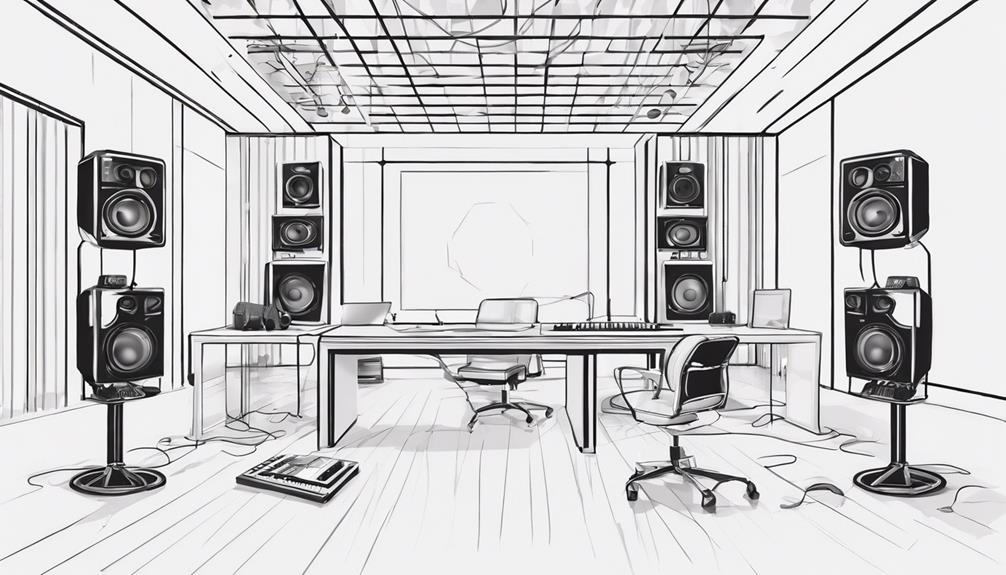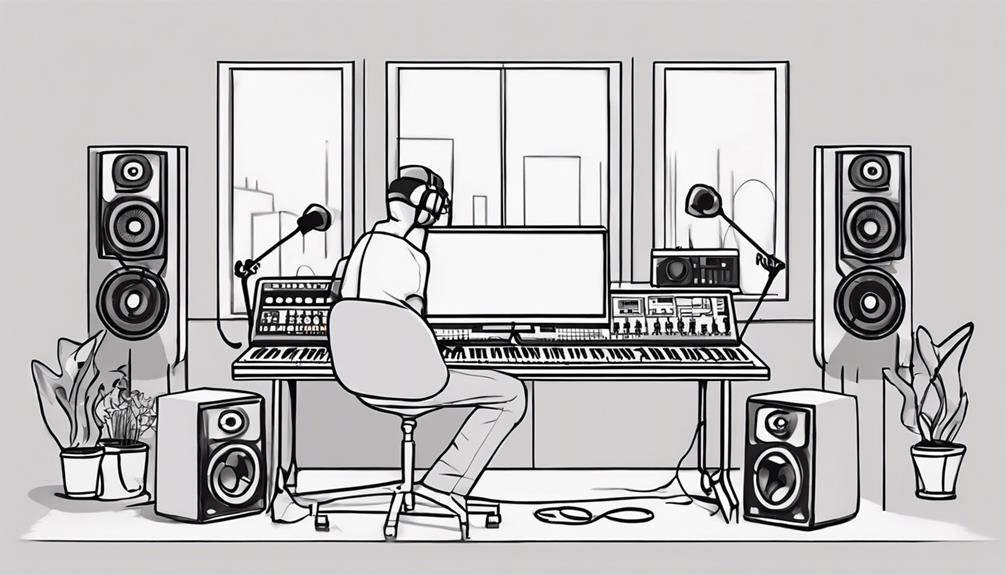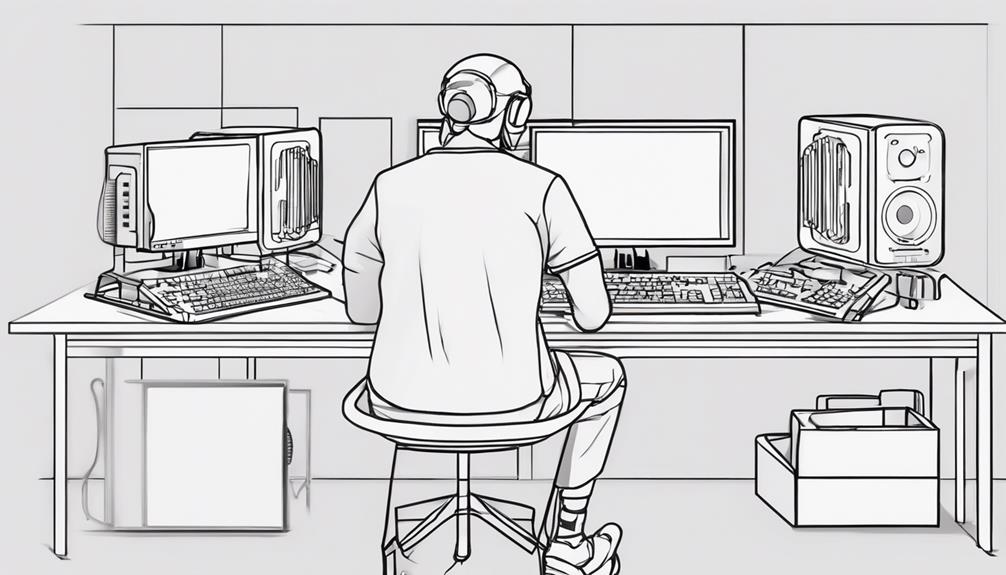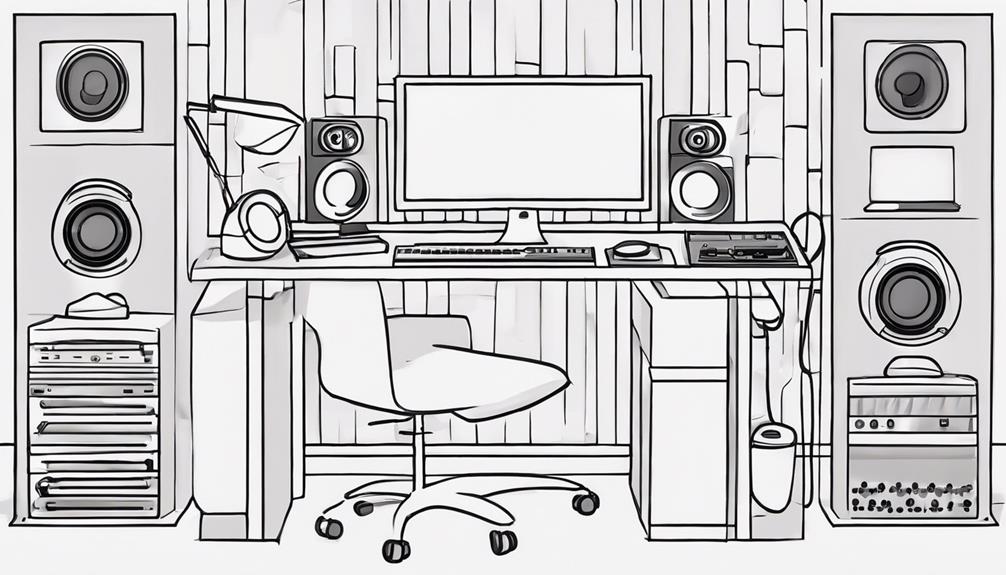Enhance your music production skills by training your ears with focused exercises and active listening. Recognize frequencies, chords, and effects to refine your skills. Practice critical listening techniques to identify nuances in mixes and enhance emotional depth in songs. Experiment with EQ, understand music theory basics, and mix at low volumes for clearer perception. Utilize reference tracks, systematic ear training, and engage in melody recognition exercises for improved results. Keep exploring the provided strategies to elevate your music production capabilities further.
Key Takeaways
- Practice active listening techniques to focus on frequencies, dynamics, and effects.
- Engage in systematic ear training exercises for pitch, melody, and arrangement recognition.
- Use reference tracks for benchmark analysis and improved critical listening.
- Experiment with EQ on popular songs to identify and understand various frequencies.
- Incorporate mixing at low volumes to prevent ear fatigue and enhance critical listening.
Ear Training Fundamentals
To develop your ear training fundamentals effectively, focus on recognizing frequencies, understanding chords, scales, and intervals, and mastering audio effects.
When it comes to improving your ear for music production, engaging in ear training exercises is essential. Start by listening actively to different notes, chords, and scales in various musical pieces. This practice will help you become more attuned to the nuances of music and enhance your ability to identify different elements within a composition.
Active Listening Techniques

Focus on the details when listening actively to music, honing in on frequencies, dynamics, and spatial elements.
Enhance your skills by adjusting volume levels, panning, and EQ settings, allowing you to analyze instrument separation, depth, and clarity.
Sharpen your proficiency by identifying effects like reverb, delay, and modulation in a mix, ultimately improving your ear training for music production tasks.
Focus on Details
By actively tuning into specific details within a music production, you can enhance your critical listening skills and grasp the intricacies of a mix. When focusing on the details, ear training techniques can greatly improve your ability to hear chord progressions, instrument nuances, and sound effects within a track.
Listening to something with a keen ear for detail allows you to discern the placement of instruments in the stereo field, the balance of frequencies, and the subtle variations that make up a perfect mix.
To develop your skills in this area, try isolating different elements of a song during playback. Pay attention to how each instrument interacts with the others, how effects are applied, and how the dynamics shift throughout the piece.
Practice Critical Listening
Engage in active listening techniques to practice critical listening skills essential for honing your music production abilities.
Vital listening involves focusing on the physical details of a mix, such as frequencies, panning, and dynamics. By paying attention to these elements, you can identify areas that need improvement and make adjustments to enhance the overall quality of your music.
Additionally, analytical listening plays an important role in understanding the emotions and meaning behind a song, aiding in making creative decisions during the production process.
To improve your music production skills, it's beneficial to combine both critical and analytical listening techniques. Compare your mixes to professionally mixed songs to pinpoint areas for growth and learn from established industry standards.
Seeking feedback from other producers can also provide valuable insights and fresh perspectives on your work, helping you refine your craft and produce music of higher quality.
Practice these active listening techniques consistently to sharpen your ears and elevate your music production capabilities. Practice these active listening techniques consistently to sharpen your ears and elevate your music production capabilities. Equally important is creating an environment that supports critical listening by treating a room for acoustics. Using sound-absorbing panels, bass traps, and diffusers can help eliminate unwanted frequencies and ensure you hear your mixes accurately, allowing you to make more informed creative decisions.
Frequency Identification Strategies
Experiment with EQ on popular songs as a strategy to enhance your ability to identify different frequencies. By listening closely and adjusting the EQ settings, you can train your ears to recognize various frequencies like the root note, scale degrees, and overlapping frequencies in a mix. This practice will help you achieve clarity in your mixes and avoid muddiness caused by conflicting frequencies.
When comparing your mix to professionally mixed songs, pay attention to the frequency balance. Identify discrepancies in the distribution of frequencies to pinpoint areas for improvement in your own music production.
Seeking feedback from other producers can also help you identify flaws in frequency distribution within your mix, guiding you towards a more balanced and polished sound. Developing a keen ear for frequencies is essential for honing your music production skills and creating high-quality tracks.
Understanding Music Theory Basics

You must grasp the fundamentals of music theory basics to excel in music production.
Key signatures play an important role in determining the tonality of a piece, while understanding chord progressions aids in creating dynamic musical arrangements.
Developing a solid foundation in music theory will elevate your composition skills and allow you to craft harmonious melodies effortlessly.
Key Signature Importance
Understanding the importance of key signatures is fundamental in grasping the basics of music theory for music production. Key signatures serve as a roadmap for musicians, indicating the group of pitches that a piece of music will use and helping to establish its tonality and harmonic structure.
Here are three key points highlighting the significance of key signatures:
- Foundation for Tonality: Key signatures are essential for establishing the tonal center of a piece, providing a framework for building chords and scales that harmonize with the chosen key.
- Identification of Chords and Scales: By recognizing the key signature, musicians can easily identify the chords and scales that are commonly used within that key, aiding in composition and improvisation.
- Integral Part of Music Theory: Key signatures play a critical role in music theory, serving as the basis for understanding chord progressions, modulation, and overall musical structure. Mastering key signatures is essential for any music producer looking to enhance their skills in composition and arrangement.
Chord Progressions Breakdown
To understand chord progressions effectively, grasp the basics of music theory, particularly major and minor chords. Chord progressions are the foundation of a song's structure, guiding its emotional impact and narrative flow. By analyzing and deconstructing chord progressions, you can deepen your understanding of music theory and composition. Common progressions like I-IV-V and ii-V-I are fundamental in various music genres, shaping the tonal center and creating harmonic resolution.
| Common Chord Progressions | Description |
|---|---|
| I-IV-V | Provides a sense of resolution and stability. |
| ii-V-I | Common in jazz music, leading smoothly back to the tonic chord. |
| vi-IV-I-V | Popular in pop music, creating a catchy and uplifting feel. |
Mastering Audio Effects

Mastering audio effects is essential for achieving professional-quality music production. Understanding the nuances of audio effects like EQ, reverb, and compression can greatly enhance the sound of your tracks.
Here are three key reasons why mastering audio effects is vital for your music production journey:
- Enhanced Sound Sculpting: Mastery of audio effects allows you to precisely shape and mold the elements of your music. By adjusting parameters like EQ settings or compression levels, you can tailor the sound to fit your creative vision.
- Professional Mixes: Learning how to use different audio effects effectively empowers you to create mixes that sound polished and professional. Experimenting with reverb to add depth or using compression to control dynamics can elevate the overall quality of your tracks.
- Stand Out: Utilizing audio effects in innovative ways can make your music stand out from the crowd. By mastering these tools, you can create unique and engaging sounds that capture the listener's attention.
Importance of Mixing at Low Volumes

Mixing at low volumes is an essential practice in music production that offers numerous benefits for achieving a balanced and polished mix. When you engage in low volume mixing, you are actively training your ears to detect subtle nuances in the music. This critical listening skill is important for identifying frequency imbalances and tonal inconsistencies that may go unnoticed at higher volumes. By practicing mixing at low volumes, you will develop a more accurate representation of your mix across various playback systems. This method enhances your ability to fine-tune EQ, compression, and other processing tools effectively. Professional engineers commonly utilize this technique to make sure their mixes are well-balanced and polished.
| Benefits of Mixing at Low Volumes | ||
|---|---|---|
| Prevents ear fatigue | Enhances critical listening | Identifies frequency imbalances |
| Promotes subtle detail perception | Helps in tonal consistency | Ensures mix accuracy across systems |
Incorporating Reference Tracks

Regularly incorporating reference tracks into your music production process is key to honing your mixing skills and achieving professional-quality results. By utilizing reference tracks, you can improve your ear for music production in the following ways:
- Benchmark Analysis: Reference tracks provide a standard for evaluating mix quality and sound characteristics, helping you identify areas in your mix that may need improvement.
- Identifying Weaknesses: Comparing your mix to reference tracks allows you to pinpoint shortcomings in areas such as balance, dynamics, and spatial elements, guiding you towards a more polished sound.
- Enhanced Critical Listening: Utilizing reference tracks not only aids in understanding these elements but also enhances your critical listening skills overall, ultimately refining your ability to produce professional-level mixes.
Incorporating reference tracks into your workflow consistently will help you develop a discerning ear and elevate the quality of your music productions.
Systematic Ear Training Exercises

Consider implementing structured ear training exercises into your daily music production routine to enhance your listening skills. Training your ears through systematic exercises is important for honing your ability to hear music more accurately.
Interval recognition exercises, where you focus on identifying the distance between two notes, can greatly improve your pitch perception. These exercises help you distinguish melodies and harmonies more effectively, leading to better musical arrangements.
To train your ears effectively, engage in activities that challenge your listening abilities, such as identifying frequencies and EQ adjustments in popular songs. Online resources and apps offer structured ear training programs tailored to enhance your auditory skills.
By consistently practicing these exercises, you can develop a more discerning ear for music production.
Collaborating with other producers for feedback and skill development can also complement your systematic ear training efforts. By sharing your progress and learning from others, you can further refine your listening skills and grow as a music producer.
Frequently Asked Questions
How to Improve Music Ears?
To improve your music ears, focus on active listening to pinpoint elements in tracks. Compare with reference tracks to analyze mix qualities. Train your ears to recognize frequencies and experiment with EQ on songs for clarity.
How to Train Your Ears for Mastering?
Imagine mastering as a puzzle – each piece a different sound element. Focus on dynamics, balance, and imaging. Train your ears by practicing with reference tracks. Use high-quality gear in a treated room for accurate decisions. Refine your skills for a professional finish.
How Do You Train Yourself to Play Music by Ear?
To train yourself to play music by ear, start by focusing on recognizing melodies and chords. Listen to songs repeatedly, trying to play them back on your instrument. Practice regularly to improve your ability and develop your ear for music.
Does Ear Training Make You a Better Musician?
Engaging in ear training is like discovering hidden treasures in music. It transforms you into a better musician by honing your abilities in pitch recognition, improvisation, and transcribing, ultimately enhancing your musical fluency and creativity.
Conclusion
As you continue to train your ears for music production, remember that just like a sculptor chisels away at a block of marble to reveal a masterpiece, you must hone your listening skills to uncover the true beauty of sound.
By actively engaging with your music, identifying frequencies, understanding theory, and mastering effects, you're sculpting your own sonic masterpiece.
Keep chiseling away, and soon you'll create something truly extraordinary.










